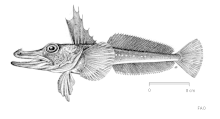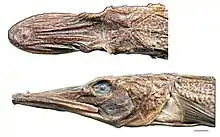Channichthys rhinoceratus
Channichthys rhinoceratus, the unicorn icefish, is a species of crocodile icefish found only around the Kerguelen-Heard Plateau in the Southern Ocean. It is a demersal species living from surface waters to depths up to 750 m (2,460 ft).[1] It is considered by some researchers as the only species in the genus Channichthys.[2]
| Channichthys rhinoceratus | |
|---|---|
 | |
| Illustration | |
| Scientific classification | |
| Kingdom: | Animalia |
| Phylum: | Chordata |
| Class: | Actinopterygii |
| Order: | Perciformes |
| Family: | Channichthyidae |
| Genus: | Channichthys |
| Species: | C. rhinoceratus |
| Binomial name | |
| Channichthys rhinoceratus Richardson, 1844 | |
Description

Described by Sir John Richardson in 1844 and being the type species of the genus Channichthys, the unicorn icefish is generally pale brown, though smaller specimens have four dark cross-bars present on each side of the body, and dark spots are present on the body, sometimes with reddish patches and dark reticulations are present. Dark spots may be present on the blackish first dorsal fin. Other fins are colored pale or dusky.[2] It grows up to a maximum length of 60 cm (24 inches)[1] and a maximum published weight of 0.5 kg (1.1 lbs).[2] A more common length is 40 cm (16 inches).[3]
Its size (being the largest of the Channichthys species) and the fact that it has the smallest eye diameter relative to snout length of the Channichthys species (28% to 31.6 %) distinguish it from its congeners. The large interorbital space of this species should also help distinguish it from C. irinae, C. bospori and C. mithridatis. [4]
Biology
This species is a typical benthic predator that feeds on fishes[1] (other notothenoids, especially the mackerel icefish Champsocephalus gunnari and other Channichthys species, however, Harpagifer fishes are also taken)[2][5] and occasionally algae.[1] It is itself preyed on by the black-browed albatross (Thalassarche melanophris). [6]
Sexual maturity is reached when it is around 36–38 cm (14–15 in) in length. This species migrates to shallower waters in January and lays 6,000 to 14,000 eggs in February. The spent fish return to deeper water in June.[2]
Although this species seems to be endemic to the Kerguelen-Heard Plateau, otoliths of this species have been found in the stomach contents of gentoo penguins nesting on Marion Island, seemingly confirming its presence there. However, there is insufficient data to prove that this species is a resident there and not just an occasional visitor. [2]
Uses
It is of minor importance to commercial fisheries,[1] caught in bottom trawls for mackerel icefish as a bycatch species. Total catches amounted to 80 tonnes (88 tons) in 2010.[7]
References
- "Channichthys rhinoceratus, Unicorn icefish". www.fishbase.se. Retrieved 2020-09-27.
- (pp.386-388) In: O.Gon and P.C Heemstra (eds). 1990. Fishes of the Southern Ocean. J.L.B. Smith Institute of Ichthyology, Grahamstown.
- "Channichthys rhinoceratus, Unicorn icefish". www.fishbase.se. Retrieved 2020-10-26.
- Shandikov, G.A. (2008). Channichthys richardsoni sp. n. , a new Antarctic icefish (Perciformes: Notothenioidei: Channichthyidae) From the Kerguelen Islands area, Indian sector of the Southern Ocean.
- Shandikov, G.A. (2008). Channichthys richardsoni sp. n. , a new Antarctic icefish (Perciformes: Notothenioidei: Channichthyidae) from the Kerguelen Islands area, Indian Ocean sector of the Southern Ocean, with comments on the taxonomic status of Channichthys normani.
- "Predators - Channichthys rhinoceratus". www.fishbase.se. Retrieved 2021-02-02.
- "FAO Catches List". www.fishbase.se. Retrieved 2020-11-21.